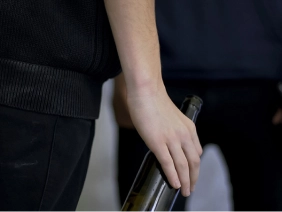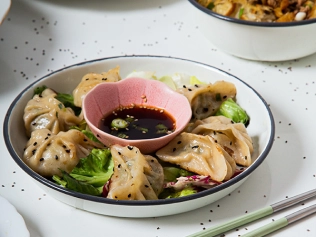
Pregnancy and diet
The information presented here is not intended to replace the advice of your doctor or healthcare professional. Please consult your doctor or healthcare professional for further information about LAL-D and its management during pregnancy.
When a child is diagnosed with LAL-D, the parents (who are carriers of the disease) should undergo genetic testing, as the risk for their next child to be affected is 25%.1At more than any other time when you are pregnant, you will be considering what you eat and whilst your body needs additional nutrients, vitamins and minerals throughout the whole of your pregnancy, it will need just an extra 350–500 extra calories each day during the second and third trimesters.
Having knowledge of which are the best nutrient dense foods, to supply these extra calories needed for your baby’s health and development is very essential.
It is particularly important when pregnant to eat regular meals of natural whole foods, making sure your diet is balanced with adequate protein, complex carbohydrates and fibre, but free from the problematic fats. Ensuring any reheated food is always piping hot before consuming, will help to reduce the risks from any potential food poisoning, as will avoiding undercooked poultry and eggs, raw fish (sushi or sashimi) and shellfish.
To avoid additional fats, steam, bake, grill or poach foods rather than fry.
Good sources:
- Fresh fruit and vegetables (excluding avocados, olives, coconut and nuts and seeds)
- Wholegrain breads
- Brown and wholegrain rice
- Beans and lentils
- Other cereals including oats, barley, buckwheat, rye, and quinoa
Animal products, diary and fish care the highest protein containing foods; however, they need to be considered carefully as they usually have the highest fat content – the exceptions being venison and veal which are naturally lower in fat.
Whilst the protein found in vegetarian foods is considered healthy, it is also a less complete form of protein, so if you are vegetarian, it is essential to combine the sources of protein from a wide range of vegetarian foods – beans, lentils, egg whites etc so your daily protein levels can be met.
Good sources:
- Skinless poultry
- Venison and veal (remove fat)
- Egg
- Fat free dairy – Quark / Sykr and fat free yogurts
- White fish
- Seafood (but not shellfish)
- Pulses
- Beans & lentils
- Wholegrains
- Oats
- Wholegrains
- Fruits and vegetables
- Beans, legumes and lentils

- Caffeine drinks Caffeine is an addictive substance and can pass through to your baby in the womb. It can also interfere with your body’s absorption of nutrients such as iron and zinc, both of which are at greater risk of becoming depleted during the pregnancy
- Refined carbohydrates Includes white flour, white rice, sugar and all things that contain them such as sweets, chocolates and fizzy drinks, these disrupt blood sugar balance and are a risk factor for elevating triglycerides
- Alcohol it is generally accepted that alcohol can have serious consequences for the growing fetus and it is advisable not to drink alcohol at all during your pregnancy
- Folic acid plays a vital role in the prevention of brain and spinal cord defects such as spina bifida. It is also important for the formation of red blood cells which transport oxygen to tissues. Sources: wheatgerm, sprouts, asparagus, broccoli, cauliflower
- Iron During pregnancy, your blood volume increases, and your red blood cell production is raised. Iron is an important element of the red blood cells that carry the oxygen in the blood to the tissues and the baby. Maintaining good iron levels throughout pregnancy may help to reduce the risks of increased fatigue and lethargy. Sources: brewer’s yeast, molasses, wheat germ, parsley, prunes dried fruit – such as dried apricots, whole grains such as brown rice and fortified breakfast cereals
- Zinc is vital for growth and cell replication and is needed for the functioning of many chemical reactions in the body. Some of your stores of zinc will be transferred to your baby during the last few months of pregnancy and early stages of breast feeding, so maintaining levels through diet is vital. Sources: fat free diary, poultry, beans, chickpeas, whole grains – rye, oats
- Calcium is needed for healthy bone formation and for controlling blood clotting mechanisms. Sources: fat free dairy, soya, leafy green vegetables, cooked dried beans
- Magnesium is important for calcium absorption and for nerve and muscle function. Sources: wheat germ, green leafy vegetables, brown rice, buckwheat and apricots
- Vitamin A / Beta-carotene aids in the growth and repair of body tissues and is needed for the healthy eyes and skin. Obtained from our diet in two forms, either from animal meats (not recommended due to the fat content), or via vegetables as beta-carotene. This can then be converted into vitamin A when it is needed, as long as zinc supplies are adequate. Sources: Beta-carotene is found in all red, orange and yellow coloured vegetables as well as dark green vegetables like spinach and kale
- Vitamin C is a water-soluble vitamin and cannot be stored by the body. It helps iron to be absorbed. Sources: Melon, all berries, guava, kiwi, apricot, avocado, broccoli, peppers, red chilli
- Vitamin K is essential for blood clotting and for healing the womb after the birth of the baby. It is normally produced by gut bacteria, but it is also available from cauliflower and all the green leafy vegetables
Sports and exercise
Following any exercise, it is important to eat within 30 minutes of finishing, to enable your body to refuel the energy it has just used, and to help to repair any microdamage to the muscles.

Alcohol and drug misuse
Although many people enjoy drinking alcohol, which can be a large part of their social life, it is important to remember that alcohol can have serious adverse effects on people’s health. Drug misuse or abuse is the of use illegal drugs...

Healthy eating when dining out
Unfortunately, for those with LAL-D eating fast foods is not an option – processed meats, burgers, fried chicken and fish, along with fries are all off the menu. This doesn’t mean you can’t eat out though, more you need to be a little more selective...
